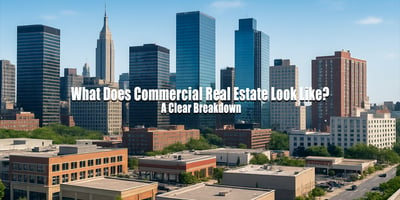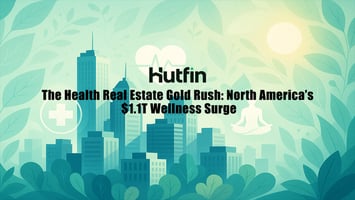The Commercial Real Estate Dictionary to Avoid Rookie Mistakes
Here's the uncomfortable truth: You can't win a game when you don't even know the language.
I learned this the hard way during my first commercial real estate meeting. The broker started throwing around terms like "cap rates," "triple net," and "debt service coverage ratio." I nodded along like I knew what he was talking about, but inside I felt like a tourist trying to order food in a foreign country.
That meeting cost me a $2 million deal because I was too embarrassed to ask what anything meant.
Don't be me. Learn the language first, make money second.

The Big Four: Terms That'll Make or Break Your Deal
Cap Rate (Capitalization Rate)
What it is: The return on investment you'd get if you bought the property with all cash.
Why it matters: This is how commercial properties are valued. Period.
The formula: Net Operating Income ÷ Purchase Price = Cap Rate
Real talk: If someone tells you about a "great deal" but doesn't mention the cap rate, they're either lying or they don't know what they're talking about. It's like buying a car without knowing the price.
My friend Sarah thought she found a steal on an office building until she calculated the cap rate: 3.2%. She could get better returns buying government bonds. Crisis avoided.
Cash-on-Cash Return
What it is: The actual cash return you get on the actual cash you invested.
Why it's different: Cap rate assumes you paid all cash. Cash-on-cash assumes you used leverage (borrowed money).
The math: Annual Cash Flow ÷ Total Cash Invested = Cash-on-Cash Return
The reality check: A 6% cap rate sounds decent until you realize your cash-on-cash return is only 2% because you overleveraged the deal.
Net Operating Income (NOI)
What it is: All the money the property makes minus all the expenses to operate it (but not including mortgage payments).
The formula: Gross Income - Operating Expenses = NOI
Why brokers love it: It's the number they use to make everything look better than it is.
What they won't tell you: Operating expenses have a funny way of being higher than projected. Always add 10-15% buffer to their numbers.
Debt Service Coverage Ratio (DSCR)
What it is: How well the property's income covers the mortgage payments.
The formula: NOI ÷ Annual Debt Service = DSCR
What banks want: Usually 1.25 or higher (property makes 25% more than needed to pay the mortgage).
What it really means: If the DSCR is 1.0, you're breaking even. Below 1.0? You're paying out of pocket every month. Above 1.5? You're probably overpaying for the property.
The Lease Lingo That Separates Pros From Amateurs
Triple Net Lease (NNN)
What it means: Tenant pays rent PLUS property taxes, insurance, and maintenance.
Why it's beautiful: Your only job is to cash checks. Everything else is their problem.
The catch: Lower base rent, but more predictable income.
Pro tip: This is the holy grail of commercial leases. Residential investors dream about this stuff.
Gross Lease
What it means: Tenant pays one amount, you handle all the expenses.
Why landlords hate it: Property taxes go up? Your problem. HVAC breaks? Your problem. Utilities spike? Still your problem.
When it makes sense: When you want higher rent and don't mind the headaches.
Modified Gross Lease
What it means: Somewhere between gross and triple net. You split some expenses.
The reality: Every modified gross lease is different. Read the fine print or get burned.
Percentage Lease
What it means: Base rent plus a percentage of the tenant's gross sales.
Where you see it: Retail properties, especially shopping centers.
The upside: If your tenant's business explodes, you get a piece of the action.
The downside: If their business sucks, you're stuck with just base rent.
The Money Terms That Matter
Loan-to-Value Ratio (LTV)
What it is: How much you're borrowing compared to the property's value.
The math: Loan Amount ÷ Property Value = LTV
What banks like: Usually 75-80% max for commercial properties.
Why it matters: Higher LTV means more leverage, more risk, and higher interest rates.
Internal Rate of Return (IRR)
What it is: The annualized return on your investment over time, accounting for cash flow and appreciation.
Why it's complicated: It considers the time value of money. A dollar today is worth more than a dollar next year.
What good investors know: IRR above 12% is solid. Above 15% is excellent. Above 20% is either genius or suspicious.
The truth: Most people throw around IRR numbers they pulled out of thin air.
Capitalization (Going-In Cap Rate vs. Exit Cap Rate)
Going-in cap rate: What you're buying at today.
Exit cap rate: What you think you'll sell at in the future.
The dangerous assumption: Assuming exit cap rates will be the same or better. Markets change, and cap rates move in the opposite direction of property values.
The Lease Terms That'll Bite You
Base Year
What it means: The year used as a baseline for expense calculations.
The trap: If expenses were unusually low in the base year, you're screwed when they normalize.
Expense Stops
What it means: You pay expenses up to a certain amount per square foot, tenant pays anything above that.
Example: $5 per square foot expense stop means you pay the first $5/sf of expenses, tenant pays the rest.
Tenant Improvements (TI)
What it means: Money you give tenants to customize their space.
The budget killer: "Standard" tenant improvements have a funny way of becoming very expensive very quickly.
Smart play: Negotiate a fixed TI allowance upfront and stick to it.
Personal Guarantee
What it means: You're personally on the hook if the business entity can't pay.
When banks require it: Almost always for smaller deals or newer investors.
How to avoid it: Have a proven track record and strong financials. Or find non-recourse loans (good luck with that as a beginner).
The Market Terms That Sound Impressive

Absorption Rate
What it means: How quickly available space gets leased up.
Why it matters: High absorption = strong market. Low absorption = buyer's market.
The broker spin: They'll always tell you absorption is "strong" or "improving."
Vacancy Rate
What it means: Percentage of available space that's empty.
The distinction: Physical vacancy (actually empty) vs. economic vacancy (empty or not paying rent).
What to watch: Economic vacancy is the number that actually matters to your bank account.
Comparable Sales (Comps)
What it means: Recent sales of similar properties used to determine value.
The manipulation: Brokers will find the three highest sales in the last two years and call them "comps."
Your defense: Ask for ALL recent sales within a mile radius, not just the cherry-picked ones.
The Bottom Line Truth
Here's what nobody tells you: Half the people using these terms don't fully understand them either.
I've sat in meetings where supposed "experts" threw around fancy terminology to sound smart, but when you dug deeper, they were just regurgitating what they heard at a seminar.
Learn these terms not to impress people, but to protect yourself.
Because in commercial real estate, the person who understands the language controls the conversation. And the person who controls the conversation controls the deal.
The choice is yours: Learn the language and play with the big boys, or keep nodding along while they take your money.
Your bank account will thank you for choosing wisely.
Ready to speak commercial real estate like a pro? At Hutfin, we don't just teach you the terms - we show you how to use them to find better deals and negotiate from a position of strength. Because knowing the language is just the first step to winning the game.




